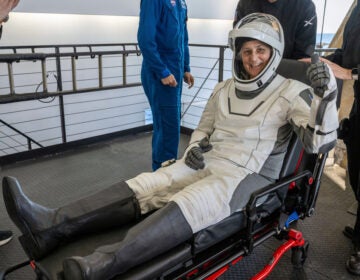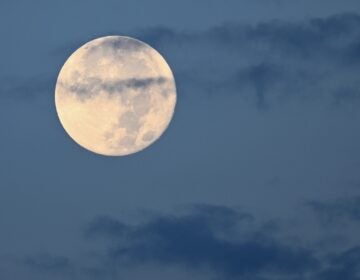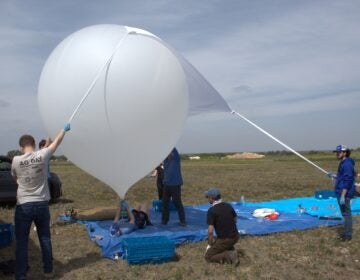Looking For Life In All The Right Places
Listen 00:05:29NASA plans to send a three-year orbital mission to Jupiter’s moon Europa as early as 2022. It’s at the top of the list of most likely places in the solar system to find life. It has a salty liquid water ocean, may have organics, definitely has a heat source to drive organic reactions and its deep ocean conditions are not much different from our deep ocean conditions.
Nine instruments are identified so far to measure heat, ice-crust thickness, ocean depth and ocean floor structure as well as chemical composition of the icy surface. Not a life-detection mission but a ‘conditions for life’ mission.
Get outside at night this month to watch Venus creep upward from Gemini through Cancer toward Leo and Jupiter.
Image: NASA/JPL/DLR
Dave Heller: The intrigue over liquid water on heavenly bodies beyond Earth is compelling NASA to set sale for Jupiter. Lets climb aboard with Derrick Pitts, Chief Astronomer at the Franklin Institute. And Derrick, specifically, its one of Jupiter’s inner moons.
Derrick Pitts: It is, its Europa that NASA would like to investigate and they have a really good reason why they want to investigate it. This is a world that has an ice crust surface. And underneath the ice crust surface is an ocean of liquid water easily as deep as the oceans here on Earth.
Oceans?
Oceans of liquid water, H2O, you know the kind of stuff we drink everyday? Yeah, that kind of stuff we drink everyday, that kind of stuff.
So very different than what we see on the surface of Mars, being remnants of what looked like were once riverbeds, but not now.
Yes, an entirely different type of scenario where as Mars definitely shows that in it’s distant history there was plenty of water on its surface, we see no liquid water on its surface now at all, anywhere. It is absolutely bone dry. But at Europa it is an entirely different situation. It is much further away from the sun. In fact it gets more heat from Jupiter than it gets from the sun. So at that distance you would imagine that if there were any water it would be frozen but in fact, it isn’t. The water that is on Europa is kept warm by the tidal effect of the giant planet Jupiter pulling on it and all of its brethren moons, some 60 plus, pulling in the other direction. So as it orbits Jupiter, the interior of the interior of the planet stays warm and the water can remain as a liquid. In fact, its actually salty, liquid water.
Interesting, where’s there’s water there’s water.
Well, there could possibly be something else as well. If we take a look at the deepest ocean regions here on Earth, places where there is absolutely no sunlight, the water pressure is so intense it could easily crush the hull of any submarine without any problem, one would expect very little nutrients. Yet there is an incredible abundance of life at these extreme depths here in our oceans. The life we find at these depths we call extremophiles. So if we were to take a look at this ocean world with the frozen crust of Europa, we find a very similar type of a situation; no light, liquid water above freezing, salty…isn’t there the slightest possibility that there could at least be organic substances that could perhaps develop into life at some point. Or at least show the building blocks of life.
Is that sub-surface water though protected by the fierce radiation around that heavenly body?
It is a really intense radiation atmosphere around Jupiter. It is not the best place for any creature, person or spacecraft to be. In fact this spacecraft is going to make 45 orbits of Europa over a 3-year period. Right now the plan is for a suite of at least 9 instruments to do the work of figuring out exactly what kind of environment Europa has, and that is in terms of its surface, its sub-surface environment even down into the water with the possibility of even being able to map the ocean floor.
Let’s be clear, none of these instruments are going to touch down on the surface.
Not on this mission. This is not a mission where they are actually heading out to detect life, but it is really a mission to try and identify the conditions for life. So, no spacecraft will touch down. It will simply be an orbital mission. Some of the orbits will dip down as low as just 16 miles above the surface, the highest will be about 1700 miles above the surface.
Proposed launch is 2022, how long does the trip take?
Long long trip. 2030 might be the earliest we can get there.
On this June 1st, let’s note that summer solstice is ahead this month. Long days, shorter nights, what’s available to be seen in the night sky this week?
After the sun sets, get outside and take a look for Venus because we will be able to watch as Venus creeps up the sky from Gemini, across Cancer, up close to Leo, where it will actually slide right up next to Jupiter on June 30th. If you start looking now in the evening for just a few minutes you’ll be able to see this motion as the two planets come closer and closer together. Apparently this also is a function of the Earth’s motion around the sun that makes it seem as if the two planets are coming close together when they are indeed more than 400 million miles apart.
When you catch sight of Jupiter do you need to squint to see Europa?
I’m afraid you will but if you have a telescope you’ll be able to see Europa and its other 3 Galilean moons without any difficulty at all.
WHYY is your source for fact-based, in-depth journalism and information. As a nonprofit organization, we rely on financial support from readers like you. Please give today.




